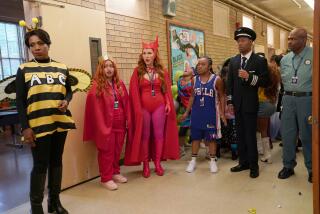Studying the Stuff of Modern Folklore
- Share via
Poisonous cheese, nauseating watermelon, new diseases, aircraft hijackings, superstitious tales of supposedly diabolical symbols--these are the building blocks of modern folklore.
That’s the opinion of Roger Abrahams, a professor of anthropology and specialist in folklore at Scripps and Pitzer Colleges in Claremont. When the news is bad and events seem to threaten everyone, people cope partly by telling stories to take the edge off catastrophe, he says.
Tales about mugging and other incidents of street violence and “the awful jokes that are going around now about AIDS (Acquired Immune Deficiency Syndrome)” are partly ways people cope with uncontrollable threats to their lives, he said in an interview.
“I think we have a global folklore that’s extraordinarily responsive to the modern world. We have stories that spring up in one place and you find them halfway around the world two weeks later,” he added.
“You can bet that any group that you go into, there will be a subject of high electricity that you can talk about, in spite of the fact that you don’t know anybody in that group,” he said. “You can get on that subject and establish a sense of instant community. Everybody has a story about getting mugged, or a terrible travel story, a chain of disasters. It’s a way of demonstrating your common denominator, that you have had experiences of the most extreme sort.”
Social Calling Cards
Today stories of close brushes with death or disaster serve both as social calling cards and as preparations for the real thing, Abrahams said.
“In order to ratify your existence as a speaking member of the community, you have to have a story on every big event that happens,” he explained. “So for instance when you have a hijacking (like that of TWA Flight 847)--I’ve heard at least 10 people talking about how close they came or their mother came or their father came or their cousin came to taking that flight. That’s the stuff of folklore.”
Abrahams believes that Americans especially use folklore as a kind of therapy for twists of fate.
“On the one hand, Americans like to be where it’s at, to be part of the action,” he said. “On the other hand, it scares them and they want to be witness to the action. They want to be set apart from it. . . . We like to be able to say we have friends who are right there at the center who told us about it. . . . One of the things you get from people who’ve been mugged or been involved in a hijacking is that so many of them say it was like on TV or they had lived it before because they had heard so many stories about it. So the stories and exposure to the news seem to be at least in one dimension a preparation for trauma, a kind of way of taking the edge off life.”
Yet, there is another side to such “preparation,” Abrahams said. “On the other hand people are afraid that this (a hijacking or a mugging) is not going to happen to them. Here they go through a whole preparation for a certain kind of anxiety experience and somehow it’s almost as if they’re wishing for it to happen to themselves.”
Then there are the modern-day folk tales that make news themselves. Abrahams cited the furor over household products manufacturer Procter & Gamble’s logo--a crescent-moon against a field of stars. For several years the company has been the focus of rumors alleging that its logo is the symbol of the “Church of Satan.” These rumors and the company’s response to them have been the subject of many news accounts. Procter & Gamble announced in April that they would drop the logo over a period of several years.
Reactions to Technology
Stories such as the ones about the Procter & Gamble logo reflect “a new kind of strange mysticism” that seems to be running through American society, Abrahams said, adding that such tales prove extremely resilient despite efforts to discredit them. They may be a reaction to the intrusions of technology into daily life, he said.
Moreover, events such as the Jalisco cheese poisonings are likely to inspire “stories that are going to have a diabolical tinge to them,” too, he said. “Almost every national trauma of the sort that causes a lot of deaths is going to generate folklore.”
It’s impossible to discover the source of such stories because “that disappears almost immediately,” Abrahams said. But he thinks these stories are told over and over because “there’s a little thrill in being associated with being up against the devil or up against death or against a destructive force.”
Observing Own Culture
Abrahams said he pays attention to these undercurrents of American culture because his study of other cultures has made him a more acute observer of his own.
“Doing field work with any culturally different group will make you wonder about your own culture,” he said. “You begin to wonder, ‘Do I have it all wrong?’ After all, this is something that works well for them (another culture). It makes you very self-conscious about the things you do.”
In the course of studying the folkways of the eastern and southern Caribbean islands and the Appalachian mountains, Abrahams said he has been led to question why he is automatically suspicious of strangers and why white middle-class Americans feel they need so much privacy.
Not all contemporary folklore involves fears and superstitions but can still have carrying power, Abrahams noted. One year in Philadelphia he noticed that the children of his neighborhood were playing a new game called Chinese jump rope. “I went to a meeting in Yugoslavia two years later and all the kids were playing it. They called it Danish jump rope,” he said, apparently because Denmark represented the ends of the earth to Yugoslavian children.
A Common Denominator
Abrahams’ experience seems to indicate that exaggeration is a common denominator in folklore wherever it’s found. His latest book, “Afro-American Folk Tales” (Pantheon, $11.95), is a collection of largely tall tales from the Caribbean region that continue to serve as a “community glue” just as our own stories about hijackings, crime or unsafe food do, he said. He also noted that decisions by local populations around the world to retain or restore their own traditions demonstrate the staying power of folklore in the face of Westernization. Folklore traditions survive, he said, because they fill needs that can’t be met by what he called “suburban culture.”
Perhaps one example of the persistence of folklore is Abrahams himself. He’s pulling up stakes in the West this summer to return to the East Coast, where he first started collecting modern urban legends on the streets of Philadelphia.
More to Read
Sign up for The Wild
We’ll help you find the best places to hike, bike and run, as well as the perfect silent spots for meditation and yoga.
You may occasionally receive promotional content from the Los Angeles Times.






